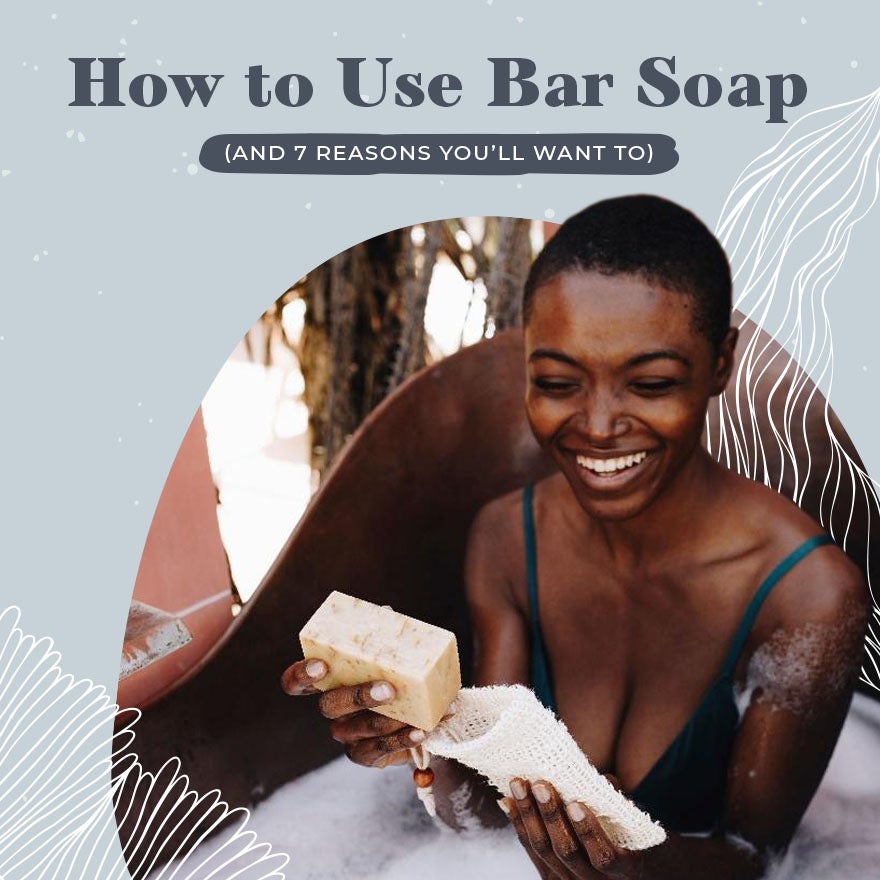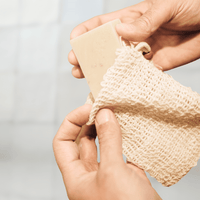
Here at The Earthling Co., we're all about products that make us feel good while helping us reduce our plastic waste. That's why today, we're shining a light on the unsung hero of our plastic-free beauty routines: the humble bar soap.
Once shunned for being overly drying on the skin, bar soaps have made a serious comeback in recent years. Today’s bar soaps now champion simple, all-natural ingredients that gently cleanse your skin and replenish lost moisture. Best of all, they come entirely package-free, making them a solid pick for both the planet and your skin.
Still, not everyone is sold on these plastic-free pucks. Some common complaints we hear about bar soap include:
“Bar soap is too slippery.”
“It gets mushy.”
“I can’t get a good lather.”
To be fair, these are valid concerns. But what if we told you that knowing how to use bar soap properly could solve most — if not all — of these minor grievances? In this article, we’re talking about the many reasons to switch to bar soap and how to use bar soap the right way to get the most out of this often-overlooked bath time essential.
Browse Our Plastic-Free Bar Soaps
Why Use Bar Soap?
Wondering what all the fuss about bar soaps is? Here are a few reasons why more and more people are ditching their liquid cleansers in favor of the humble bar soap — and why we think everyone should follow suit.
Reason #1: They boast new and improved formulas
In the past, bar soaps were known for being drying and overly harsh on the skin. These old-school formulas often featured synthetic surfactants that would cleanse the body but diminish the skin’s natural lipid barrier over time. The result was dry, irritated skin that felt tight post-shower.
Nowadays, bar soaps come in a wide range of formulas, with many featuring all-natural ingredients that hydrate your skin. At The Earthling Co., our nourishing body soap bars contain 100 percent plant-based ingredients that help your skin seal in moisture and replenish your skin barrier.
Reason #2: They’re package-free
With more people becoming increasingly aware of the role of plastic waste in climate change, environmentally-friendly packaging is not just a trend — it’s a necessity. This brings us to one of the biggest benefits of bar soap: its package-free design.
Like shampoo bars, solid bar soaps are often housed in minimal paper packaging, which helps cut back on plastic waste by eliminating the need for a plastic bottle. In fact, if everyone were to switch their body wash for bar soap, we could save an estimated 270,000 plastic bottles each year!
Reason #3: They’re waterless
When you go to buy liquid soap, you probably aren’t thinking about how much water is in its formula — but you should be. According to the World Wildlife Fund, two-thirds of the population may face water shortages by 2025.
One easy way to preserve our precious water supply? Switching to bar soap and other waterless beauty products. Not only do waterless formulas help conserve water, but they also weigh less than their liquid counterparts and therefore don’t require as much energy to transport.

Environmental benefits aside, there are other reasons to reach for waterless soap. Solid bar soaps don’t need parabens and other stabilizers to keep bacterial growth at bay. Plus, they’re highly concentrated with plant-based oils and fats, which means your skin will reap more of their moisturizing benefits.
Reason #4: They’re travel-friendly
If you’ve ever had the misfortune of having your liquids explode in your suitcase (and ruin all of your clothes), then you know why this benefit is worth mentioning. Solid bar soaps take the guesswork out of packing and help you breeze past airport security. Plus, they’re lightweight, take little space in your bag and — most importantly — won’t cause any unwelcome surprises when you arrive at your destination.
Related: Can you bring bar soap on a plane?
Reason: #5: They can double as an exfoliator
Exfoliation is a simple way to slough off the top layer of dead skin cells, which can instantly help improve the appearance of your skin. And lucky for you, many bar soaps now include ingredients that naturally exfoliate the skin, like glycolic acid and oatmeal.
Already have a bar soap you love? You can also use our sisal soap saver bag to achieve head-to-toe exfoliation. Made from naturally-derived sisal, this eco-friendly pouch has just enough texture to be an effective exfoliator without any harsh rubbing. It can create a better lather and allow you to get a tighter grip on your bar so you aren’t constantly dropping it in the shower.
As if that weren’t enough, it’s also convenient! When you’re done using your sisal soap saver, you can hang it in the shower to keep your favorite bar soap high and dry in between washes. If you want to periodically clean the sisal bag, you can boil it for a few minutes in water. Easy peasy!

Reason #6: They last longer
Does it seem like you’re constantly buying soap these days? Switching to bar soap can help you save money — not to mention countless trips to the store. Bar soaps, on average, last much longer than liquid soaps because you’re not pumping more soap than you actually need into your hands. And unlike liquid soaps, which always seem to leave a little bit of soap behind in the bottle, bar soaps can be used until every last bit is gone (especially with the help of a soap saver).
Reason #7: They’re just as effective as liquid soap
Contrary to popular belief, liquid soap isn’t more effective than bar soap. In fact, some experts argue that bar soap may be better at getting rid of germs since it creates more friction, which helps slough off dirt and debris.
Proponents of liquid soap often cite the bacteria factor as a reason to avoid bar soap. However, studies going back to 1965 show that bar soap does not transmit bacteria.
Now, does this mean that your bar soap isn’t teeming in germs? Of course not! Everything is covered in germs, and that includes your humble bar of soap. However, the bulk of these germs will probably be from your skin, and they’re literally washed down the drain when you rinse off.
The bottom line? The bacteria on bar soap is nothing to lose sleep over. But if you want to be extra cautious, you can always make sure that each family member has their own bar of soap.
How to Use Bar Soap
Bar soap instructions seem pretty straightforward: get in the shower, apply the soap to your body and rinse off. But as it turns out, there is a right way to use bar soap.
1. Choose the right bar for the job
Having a good experience with bar soap starts with choosing the right bar for your skin. There are many types of bar soaps available, and not all of them are created equal.
First off, it’s important to consider which part of your body you’ll be washing with your bar soap. For example, if you want to use bar soap on your face, make sure you choose a facial soap bar that’s specifically formulated for facial skin.

Also, be on the lookout for nourishing ingredients, such as glycerin, coconut oil, and shea butter. Avoid the following ingredients, which may be irritating or toxic:
- Artificial fragrances and dyes
- Sodium laureth sulfate (SLES)
- Sodium lauryl sulfate (SLS)
- Polyethylene glycol (PEG compounds)
- Parabens (methyl-, isobutyl-, propyl-, etc.)
Here’s a good rule of thumb to follow: if the ingredients list is absurdly long and you can’t pronounce half the words, take a hard pass.
2. Use lukewarm water
By now, you probably know that hot water isn’t great for your skin. Hot water can deplete your skin’s natural oils, making it more susceptible to dryness, acne and signs of aging.
But did you also know that it can hamper your bar’s ability to create a good lather? Bar soaps tend to work best in not-too-hot, not-too-cold temperatures, which is why many experts recommend sudsing up in lukewarm water. (As an added bonus, you’ll probably save money by lowering your water heating costs!)
3. Rub the bar in your hands to create a lather
Speaking of lather, let’s talk about how to get a good lather going with natural bar soaps. Unlike synthetic bar soaps, natural bar soaps contain no SLS or other foam boosters. Instead, they rely on a combination of oils — like coconut oil and castor oil — and glycerin to create a lovely, foamy lather. Depending on the formula, this lather may be slightly creamier than what you’re used to, but we promise that it’s just as effective at getting your body clean!
To get a good lather going, do a quick rinse to wet your skin and rub the bar between your hands for 15 seconds. Then, apply the lather to your entire body.
Keep in mind that hard water can make it notoriously difficult to create a lather. If you find this bothersome, you can always install a water softener in your home to remove the minerals.

4. Take it from the top
Always scrub from top to bottom — not the other way around. Start at your neck and work your way down to your feet. This technique will ensure that your entire body gets clean and leaves minimal soap residue behind.
Once you’ve lathered your body from neck to toe, rinse off any remaining soapy residue!
5. Keep your soap dry in between uses
This step is crucial to having a good bar soap experience! If you don’t keep your bar dry in between uses, it could eventually turn into a mushy mess.
You can make your bar soap last longer by storing it on a wooden or silicone soap dish with good drainage. We also recommend moving bar soaps out of the shower to protect them from the humidity.
Is a Washcloth or Loofah Necessary?
No, a washcloth or loofah is not necessary for cleaning your body. That said, some people find them helpful for creating a rich lather in the shower.
If you prefer to use a washcloth or loofah in the shower, make sure that you’re cleaning it regularly. Just because it comes in frequent contact with soap does not mean that it’s free of bacteria!
Aim to clean your washcloths and loofahs every three to four days. For washcloths, this could be as easy as throwing them in the wash with your regular laundry. Prefer to use a loofah? Skip the harmful bleach and wash your loofah with a hydrogen peroxide solution instead.
The Best Choice for a Sustainable Clean
Learning how to use bar soap isn’t exactly rocket science, but there is a little more to this basic beauty product than meets the eye. With the right bar of soap and the proper technique, you can get more out of your daily ablutions and finally kiss those wasteful plastic bottles goodbye. Your skin and the planet will be better off for it!
Image Credits
Romanova Ekaterina/Shutterstock.com







